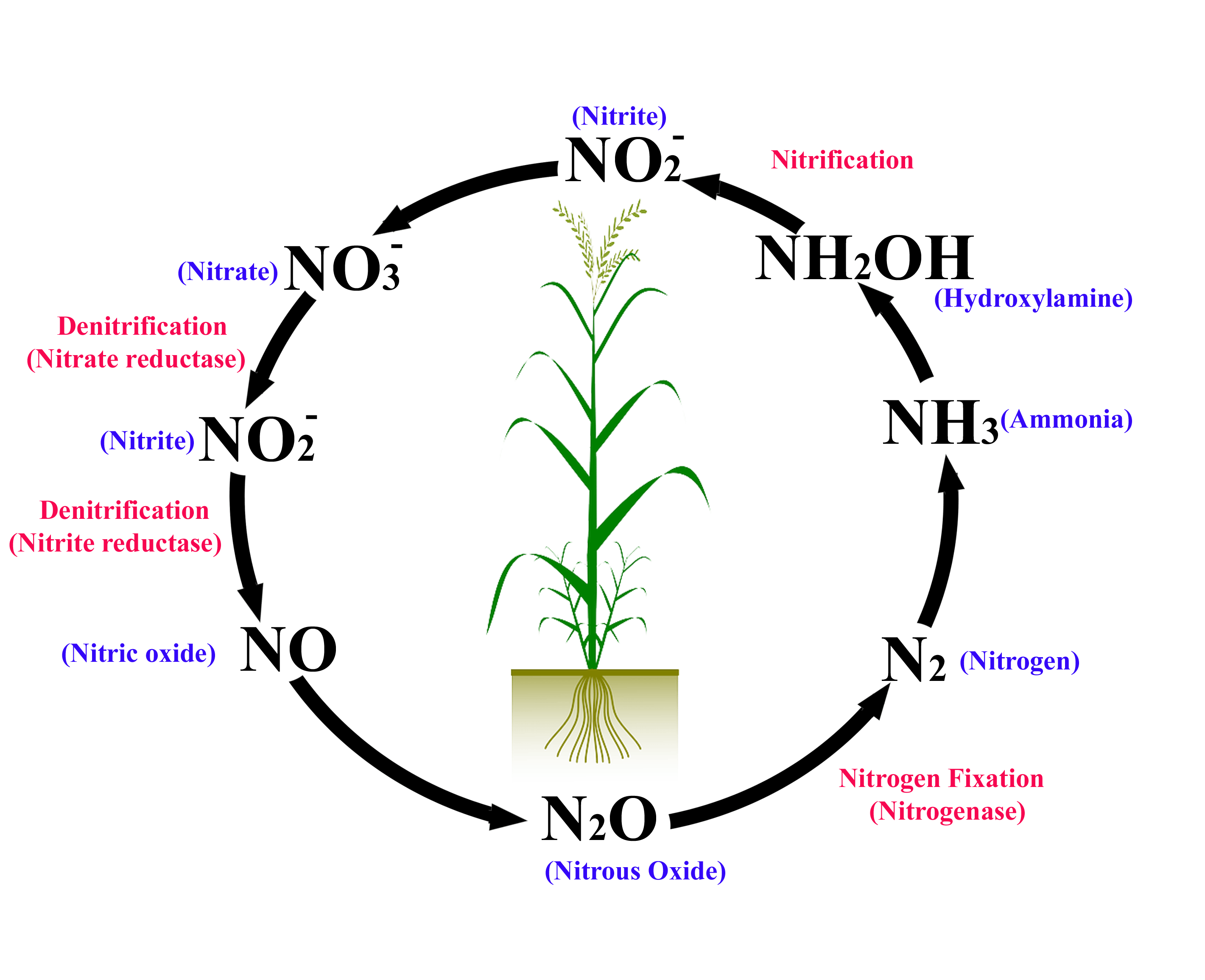Nitrogen is a crucial nutrient required in the growth and the improvement of the plant; it is also a key determinant of the photosynthetic capacity of the plant and adenosine triphosphate (ATP) which is the fundamental source of energy. N and C metabolism are closely linked together. (Zhong et al., 2018) has stated that the rate of photosynthesis is decreased when the activities of N metabolic enzymes such as Glutamine synthetase (GS), Glutamate synthase (GOGAT), nitrate/nitrite reductase (NR/NiR), and glutamine dehydrogenase (GDH) is decreased.
Nitrogen cycle

N can be found in diverse inorganic and organic forms in our environment. Whereas inorganic N exists as nitrate, reduced ammonia, and oxidized nitrite, organic N consists mainly of cell compounds and amino acids. The nitrogen cycle consists of several reactions, including ammonification, nitrification, denitrification, and nitrogen fixation. Nitrogen fixation occurs in plants with the aid of specialized microorganisms that have the ability to convert atmospheric nitrogen directly to ammonia, which is easily absorbed by plant roots. Bacteria like rhizobium, azotobacter, and cyanobacteria aid the plant in converting atmospheric nitrogen to ammonia.
inorganic form is present as nitrate, reduced ammonia, and oxidized nitrite, organic N consists of primarily cell compounds and amino acids. The nitrogen cycle primarily comprises various reactions such as ammonification, nitrification, denitrification, and nitrogen fixation. Nitrogen fixation takes place in plants with the help of specialized microorganisms which contains the ability to convert atmospheric nitrogen directly to ammonia, which plant roots can easily take up. various bacteria such as rhizobium, azotobacter, and cyanobacteria help the plant to convert atmospheric nitrogen to ammonia (NH3). In ammonification the conversion of organic nitrogen into ammonia takes place.
Organic N + microorganism –> NH3/NH4+
H2NCONH2(Urea) + 2H2O urease >à(NH4)2CO3, UreaàNH4+àNH3
Nitrification is the process in which oxidation of ammonium takes place. The process takes place in two steps: in the first step ammonia is converted into nitrite by Nitrosomonas, and in the second step Nitrobacter converts nitrite into nitrate, which is consumed by the plants (Rana et al., 2019).
2NH4+ +3CO2 –> 2NO2– +4H+ +2H2O (1st step)
2NO2– + O2 –> 2NO3– (2ndstep)
The ultimate step of the nitrogen cycle is the method of conversion of nitrate to nitrite and then nitrite to Nitrogen gas this step is known as denitrification. The process is accomplished by a variety of microorganisms/fungi. Pseudomonas, Bacillus, and Paracoccus are some of the bacteria which help in the process of denitrification.
Nitrogen metabolism
Nitrogen is a necessary element for plants. Plants absorb nitrogen from ammonium and nitrate, with nitrate playing a critical role in growth and development. Nitrate is an unstable substance that is stored in vacuoles. However, Nitrate, on the other hand, is required for the biosynthesis of amino acids, proteins, and other nitrogenous compounds such as nitrogenous bases. For the synthesis of nitrogenous compounds, nitrate must be reduced to ammonium. The enzymes nitrate reductase (NR) and nitrite reductase (NR) catalyze the reduction of nitrate to nitrite followed by nitrite reduction to NH4+ (NiR) (Balotf et al., 2016). 30-40% of total N in rice plants is taken in the form of NO3-. Roots of the rice help the plant in the uptake of nitrate which is diminished to nitrite by NR in the cytoplasm and NR is further reduced to NiR in the plastids(Gu & Yang, 2022). There are two families of transporters NRT1(A nitrate transporter) or NPF (a nitrate peptide transporter family) and NRT2, these transporters are responsible for nitrate transport. Plants take nitrogen mainly in the form of NH4+in hypoxic paddy fields. The transport of NH4+ ions is mediated by ammonium transporter genes (AMT). There are 12 AMT genes divided into 4 subfamilies.
Nitrogen assimilation

Nitrogen uptake in plants occurs in the form of nitrates and ammonium ions, which are actively transported by transporters. Nitrates are converted into ammonia after uptake and then into amino acids. Nitrate reduction is a two-step process in which nitrate is reduced to nitrite in the cytoplasm by the enzyme nitrate reductase (NR). The enzyme nitrite reductase reduces nitrite to NH3 in chloroplasts in the second step (NiR). Later, the NH3 is converted into glutamate, which is then converted into glutamine by the enzyme glutamine synthetase (GS).
NH4+ is either derived or taken directly from ammonium transporters (AMTs). NH4+ is further incorporated into amino acids via the GS-GOGAT (glutamine synthetase-glutamine-2-oxoglutarate amino transferase) cycle. The enzymes involved in this cycle are GS1, GS2, and NADH-GOGAT. When the level of NH4+ is high under stress conditions NADH-GDH(glutamate dehydrogenase) is a mitochondrial enzyme that can incorporate NH4+ into Glu.
References
- Zhong, C., Cao, X., Bai, Z., Zhang, J., Zhu, L., Huang, J., & Jin, Q. (2018). Nitrogen metabolism correlates with the acclimation of photosynthesis to short-term water stress in rice (Oryza sativa L.). Plant Physiology and Biochemistry, 125, 52–62. https://doi.org/10.1016/J.PLAPHY.2018.01.024
- Balotf, S., Kavoosi, G., & Kholdebarin, B. (2016). Nitrate reductase, nitrite reductase, glutamine synthetase, and glutamate synthase expression and activity in response to different nitrogen sources in nitrogen-starved wheat seedlings. Biotechnology and Applied Biochemistry, 63(2), 220–229. https://doi.org/10.1002/bab.1362
- Rana, A., Pandey, R. K., & Ramakrishnan, B. (2019). Enzymology of the nitrogen cycle and bioremediation of toxic nitrogenous compounds. Smart Bioremediation Technologies: Microbial Enzymes, 45–61. https://doi.org/10.1016/B978-0-12-818307-6.00003-2